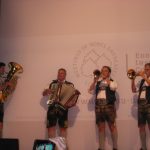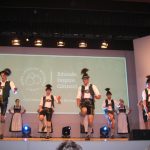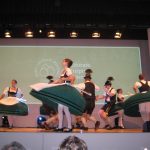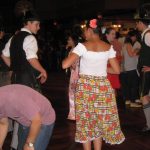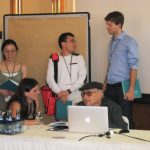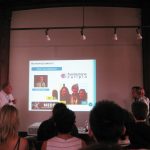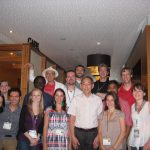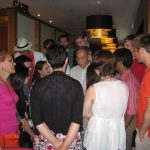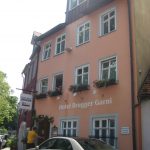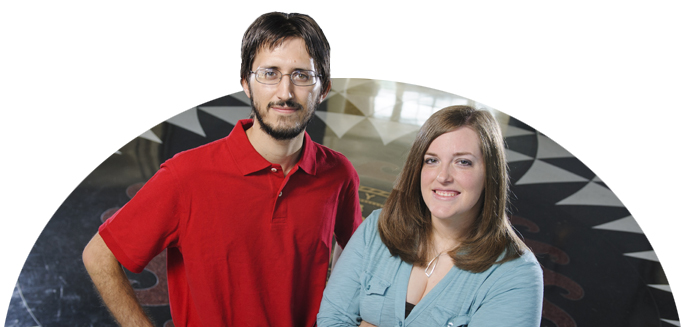 Since 1901, 835 individuals have been selected as Nobel Prize winners in recognition of those who have “conferred the greatest benefit to mankind” during the preceding year. Thirty-five of these Nobel winners, known as Nobel Laureates, will gather at Lake Constance, Germany from June 30 to July 5. In their midst will be some of the world’s brightest young scientific minds, including two University of Alabama graduate students, Steven Kelley and Michele Stover.
Since 1901, 835 individuals have been selected as Nobel Prize winners in recognition of those who have “conferred the greatest benefit to mankind” during the preceding year. Thirty-five of these Nobel winners, known as Nobel Laureates, will gather at Lake Constance, Germany from June 30 to July 5. In their midst will be some of the world’s brightest young scientific minds, including two University of Alabama graduate students, Steven Kelley and Michele Stover.
Stover, a native of Moselle, Miss., and Kelley, a native of Olive Branch, Miss., are among the 600 young researchers from nearly 80 countries tabbed for the opportunity of learning from, and interacting with, these scholars.
The pair of UA College of Arts and Sciences students will periodically blog about their learning adventure over the next several days. Come along as they share first-hand their accounts of the annual Lindau Meetings, typically covered by some 130 journalists from 40 countries.
 Humans First, Scientists Second – July 5
Humans First, Scientists Second – July 5
Steven Kelley
The final day of the Lindau Meeting is upon us at last. However, we were to be sent off in style.
The closing ceremonies for the Lindau Meeting are held on Mainau Island, the home of the Bernadotte family. Count Lennart Bernadotte co-founded the meeting 63 years ago as part of the effort to restore the German scientific community following World War II. His daughter, Countess Bettina Bernadotte, is the president of the Lindau Nobel Laureates Meeting committee.
To reach the island, both the young researchers and Nobel Laureates were sent across Lake Constance in a fabulous chartered boat sponsored by the state of Baden-Württemberg.
The weather was cold and drizzly on our cruise across Lake Constance, but, fortunately, it improved in time for the panel discussions, which were held outdoors. We had a socio-politically themed discussion titled “Challenges to Peace and Justice in the 21st Century,” featuring two distinguished guests, Gunnar Stålsett, Bishop of the Church of Sweden, and José Ramos-Horta, Noble Peace Prize Laureate and former president of East Timor.
The next discussion, titled “Green Chemistry,” was led by Professors Steven Chu and Mario Molina, along with scientist and noted environmental activist Dr. Michael Braungart. I found both to be rather solemn calls to action for young researchers.
The panel was followed by lunch along with free time to explore the island. I wound up with a young researcher from Germany who lived and worked on the other side of the lake (she even showed us her university from the island), so I received a “guided tour.”
Mainau Island was made into a botanical garden, now open to the public for touring. The climate is quite similar to Alabama, and there were many specimens on display which can be found in the Southeast U.S. The setting was particularly fitting for reflecting on what we, as scientists, ought to protect, which was an underlying theme of the meeting.
The closing ceremony was held in the courtyard of the Bernadotte castle, with addresses from the Countess, one of the young researchers, and closing remarks from Professor Chu. The students and Laureates had one last opportunity to interact with one another on the boat ride back to Lindau.
Once the boat landed and we disembarked, that was that. The meeting was over and we all headed off in our own directions; some back home, some to recreational destinations in Europe, and more than a few to visit the institutions and labs of their new colleagues before leaving.
For me, the main lesson from the meeting wasn’t about career building, how to do research like a Laureate, or even the global scientific challenges we face. I think the most important lesson the Laureates had for us was summed up nicely by Professor Chu’s closing words: We are humans first, and scientists second. Our motivation for doing research is simply that we enjoy the thrill of discovery. The motivation for using science to help society doesn’t come from the arrogant assumption that we are the only ones who can devise the technological solutions to our problems. We simply have the same sense of duty all people have to help others in need, and we’re using whatever skills we have to help.
That closes a once-in-a-lifetime experience, and I hope I can carry what I learned to represent The University of Alabama strongly throughout my career.
Roll Tide!
 Einstein, German Chocolate and Climate Change — July 4
Einstein, German Chocolate and Climate Change — July 4
Michele Stover
I awoke today, a little tired and with feelings of joy, sadness and anxiety. Today is our final day in Lindau, as the meeting officially closes tomorrow on Mainau Island, home to the Bernadotte family. I am sad the meeting is nearing its end; however, I cannot help but feel immense joy at having this experience that I will never forget.
Today began, as the days have all week, with seven plenary lectures before lunch. This time two stuck out in particular to me. Mario Molina spoke on the need for better ways of communicating climate change science. He spent 25 minutes showing facts and data about climate change and ended his talk with a staggering statistic. Between 97-99 percent of scientists agree that climate change is due to human activity. However, only 27 percent of the public shares this opinion. This means that better communication is a big problem in science, and discussion on possible solutions is in order.
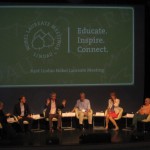
One way we accomplished this was by having a panel discussion after lunch titled “Why Communicate.” The discussion was split into two parts: communication of scientists among themselves and communication between scientists and the public. Several interesting and almost controversial topics such as making science open access, media as the moderator between scientists and the public, and the difficulty of explaining the importance of basic research to funding agencies and the public. It was quite an amazing discussion, and it showed me how important the issue of communication is all around the world.
The other talk that stood out to me was by fan favorite Harold Kroto. The part that resonated with me the most was when he showed us pictures of unknown famous scientists. He started with a picture of a young-looking man and asked if we knew who it was. The crowd consensus was “no.” He moved on to the next slide to reveal it was young Albert Einstein who, by age 15, was already pondering the questions that later led him to some of the greatest discoveries in science.
He continued with several more examples, but the moral of the story was clear to me. Now, right now, is the most important time in our scientific careers. A possible groundbreaking discovery could be just around the corner for me, or any one of the colleagues I have met here in Lindau. This is a very exciting though!

The anxiety I mentioned earlier entered into the equation when I, and most of my fellow Americans, realized we still had not gotten souvenirs or chocolate, and we were running out of time. So, after a very quick lunch today, and before the panel, we did some shopping! I think I got enough chocolate, but I’m not sure. Maybe you can let me know if I need more.
The day ended with Bavarian Evening, an entire evening dedicated to sharing the culture if Bavaria with the rest of the world. Also, international students were encouraged to wear customary clothing from their countries. My roommate here in Lindau, Nella, is Puerto Rican. She, along with many others, took advantage of this to make an amazing evening of culture and customs. In other words, great food, beautiful, customary clothing, and folk music you just can’t help but dance to, led to the perfect way to say goodbye to our international friends.
 Climate Change, Renewable Energy Recurring Themes — July 3, 2013
Climate Change, Renewable Energy Recurring Themes — July 3, 2013
Steven Kelley
I began my third day at the Lindau meeting with the plenary lecture session. There were six lecturers today. I enjoyed the variety. Professors Martin Chalfie, Peter Agre, and Kurt Wüthrich gave highly technical talks on their research, while Professor Steven Chu discussed energy and climate issues facing the U.S. and the world. Professor Dan Schechtman spoke on his initially controversial discovery (of something known as quasicrystals), and Professor Richard Ernst gave a talk on his passion for Central Asian art and culture and how having passions outside of science have helped his career.
The U.S. delegation of young researchers got the opportunity to have lunch with the Nobel Laureates at the Restaurant Viamala, just outside the Spielbank casino on the island. I, and eight of my peers, sat with Sir Walter Kroto, one of the winners of the 1996 Nobel Prize in Chemistry for the discovery of fullerenes. (He also does graphic design and enjoyed the movie “Sideways”.)
After the lunch break, we had the first panel discussion of the week. In addition to being a forum for meeting the Nobel Laureates and each other, the Lindau meeting is a chance to bring matters of international importance to the attention of the scientists. Climate change and renewable energy have been recurring themes throughout the week.
The discussion, titled “Chemical Energy Conversion and Storage,” was led by a panel of four laureates (Professors Robert Grubbs, Hartmut Michel, Gerhard Ertl and Richard Schrock) and moderated by Professors Astrid Gräslund and Wolfgang Lubitz, members of the Council for the Lindau Nobel Laureate Meetings.
The panel discussed questions submitted in writing by the young researchers with a little time for questions from the audience at the end.
Discussions with individual Laureates took place after the panel. I was especially interested in hearing more from Professor Schechtman, whose discovery had a major effect on the science of crystallography, which I study. Schechtman gave a particularly energetic and interesting lecture that morning. I was not surprised to find his session was a full house, and my fellow researchers had a lot of insightful questions about his unusual discovery and career.
He used his stories to convey his own lessons on matters such as scientific research, career building, and, most memorably to me, the relationship between periodic arrangements in space and their aperiodic projections into space of lower dimensionality.
After the discussion session, we young researchers had a free evening, so I was able to visit with a few of my American colleagues and some researchers from the German and Uruguayan delegations. I also had to scope out some gift shops for souvenirs, because, unfortunately, we don’t have much time left in Lindau.
 ‘Gramma of the Year’ is a Nobel Laureate – July 2, 2013
‘Gramma of the Year’ is a Nobel Laureate – July 2, 2013
Michele Stover
After two solid days of conference, I find myself becoming more comfortable with branching out on my own. No longer do I cling to the comfort of the presence of my American colleagues. At this point, I let the conference, and my scientific curiosity, be my guide.
The day began with seven plenary talks by Nobel Laureates before lunch. At this point, I find myself almost overwhelmed by the amount of information I have heard, so taking notes has been key. Today, we heard a variety of different chemistry talks, but one, in particular, stood out for me.
We heard from Professor Ada Yonath who, in 2009, became the fourth woman ever to win the Nobel Prize in Chemistry. Throughout her lecture, she showed videos and made jokes to help us understand and get us interested in her research. At the end of her talk, she spoke to the women in the audience. She said, “you can have a family and still be a scientist.”
As an example, she showed us a picture of her Nobel Prize medal. On the following slide, she showed us another award she cherished. It was a hand drawn note that read “the gramma of the year.” It was so sweet.
I was personally looking forward to Professor Yonath’s talk because I was hoping she would address the issue of women in science. She showed me, and every other girl in the room, that we do not have to give up our dreams of changing the world with research if we decide to have children one day. I have to admit that this has always been a worry of mine. I have always felt torn and thought it was an impossible task, but, if Professor Yonath can do it, then why not me?!
After lunch, I got to hear a lecture from the person I was most excited about hearing from since first learning I would get to attend this conference: Professor Walter Kohn.
As a computational chemist, I was very interested to hear from the man who won the Nobel Prize for discovering something that I now use almost every single day in my own research. However, when I looked in the schedule, I saw that he was not speaking on density functional theory but on macular degeneration. I won’t lie; I was quite disappointed.
Well, at least I was until he started speaking. Turns out, his wife suffers from the disease and has already lost her sight in one eye. He began studying the disease after her diagnosis. After realizing the depth of his dedication and love for his wife, I could feel nothing but excitement to hear what he had discovered.
After hearing from Professor Kohn, it was time for my master class. A master class is a chance for young researchers to present their research in front of the top scientists in their field — an absolutely amazing opportunity. Sadly, none of the master classes were in my specialty, but I signed up to attend one anyway to see what it was all about. It turned out to be a really cool interaction with Professors Kurt Wüthrich and Richard Ernst, Nobel Laureates who led the class.
It was nice to see how personable the Laureates are and how much they care about our success. Professor Wüthrich was happy to step in any time a young researcher struggled with a question from the audience, and he did so in the nicest and most respectable way. I was very impressed.
The day ended with dinner with the Laureates and the rest of my American colleagues. To all of our joys, Professor Steven Chu and his wife joined us for dinner. He was on board for anything from taking tons of pictures to discussing research to entertaining us with stories.
So far, the conference is only half way over, yet I feel like I have had more priceless experiences than I have ever had in all of my previous meetings, combined. I am so happy to be representing The University of Alabama, my home state of Mississippi, and just the South, in general, at this meeting.
I say the South, in general, because my accent has not gone unnoticed. I can barely get past my name before people ask where I am from. But, this has led to an additional part of the conference that I have enjoyed immensely: Sharing stories with other Americans, and people from all around the world, about where we came from, who we are, and where we would like to go in life.
I wish you all could experience this with me, but, since you can’t, I hope this blog gives you some insight into what is going on here.
Thanks for being on board with us! Wiedersehen für jetzt
 Waltz this Way – July 1, 2013
Waltz this Way – July 1, 2013
Steven Kelley
Today was the first day of lectures at the Lindau Meeting. For me, it began early. All the young researchers register for one of four “Science Breakfasts.” I attended one sponsored by the Republic of Korea titled “How Does Surface Science Contribute to Solve Global Energy and Environmental Issues?”
They packed a lot into a one-hour breakfast. The young researchers were allowed to mingle and eat at the beginning (fortunately I made it on time). Afterward, there was a seminar followed by a panel discussion with a professor and graduate student from the Korea Advanced Institute for Science and Technology and Prof. Gerhard Ertl, the 2007 chemistry Nobel Laureate.
Immediately after breakfast, I trekked back across the island for the plenary sessions. Seven half-hour long talks were given throughout the morning before all the young researchers. The breadth of the talks given today was truly astounding. Even the Laureates must have learned a few new things at the plenary lectures.
Topics ranged from the basic chemistry that powers cellular life to the synthesis of new molecules and the study of proteins on which those molecules act, all the way to bizarre quantum physical phenomena that could be used in future information technology.
After lunch the young researchers were split into smaller groups for 90-minute long, informal discussion sessions with the Laureates. All of today’s talks were outside my normal area of research, but Dr. David Wineland’s experiments in studying quantum mechanical systems did the best job of capturing my imagination. I attended his Q&A session along with about 30 other young researchers.
We were permitted to ask anything, and there was no form or moderator. Questions about Dr. Wineland’s research, our own research, building a career, and secrets to winning the Nobel Prize were all discussed. I later learned that most of the other discussion sessions ran this way, which, of course, fits the regularly iterated intent of the meeting – to allow informal, cross-generation discussion between the Nobel Laureates and ourselves.
The State of Korea sponsored an international get-together for dinner in honor of International Korea Day, with Korean-themed food and entertainment. I was caught somewhat off-guard when all the men and women were asked to parade around the dinner hall arm-in-arm and then participate in the first dance of the evening.
This event is apparently called the Lindau Promenade and an important tradition in the meeting. I don’t know how to waltz, but, luckily for me, neither did my partner, Venuka, from the Indian Institute of Technology in Bombay, so I was able to get away with just blending in.
 ‘An Awe-Inspiring Moment’ — June 30, 2013
‘An Awe-Inspiring Moment’ — June 30, 2013
Michele Stover
The day began kind of slowly. Jet lag is a friend to no one. After being awake for almost two days straight, a good night’s sleep is what we all needed.
After awaking to one of the most unique views I have ever had in a hotel, I wandered around the island for an hour or so to try to get my bearings. It has to be one of the most beautiful little towns on earth.
After a quick lunch with a few of my American peers, it was time to get ready for the opening ceremony. It opened with a short video about the meeting, and then I heard an announcer’s voice say, “Please welcome the Nobel Laureates of the 63rd Lindau Nobel Laureates meeting.”
I looked up to see the Laureates walking into the room while a video of their names and pictures played on the screens behind them. It was an awe-inspiring moment. I had chills. The reality of the grandness of what I was about to experience over the next week had finally hit me. I knew, at that moment, this would be a week I would never forget, and that I would never be the same when I returned.
The ceremony continued with a welcome from Countess Bettina Bernadotte, president of the Council, and several other officials from the meeting. Then, they announced the three new members who were going to be inducted to the Honorary Senate of the Foundation Lindau Nobel Prize Winners Meeting at Lake Constance.
We saw videos of each of their accomplishments and heard, in person, from two of them. Their stories of giving back were inspiring and were a great reminder that even if I never become a Nobel Laureate myself, there are still many ways that I can give back to the people of the world and leave a legacy that will never be forgotten.
After the ceremony, we attended a concert by the Vienna Philharmonic Chamber Orchestra. The performance was absolutely amazing and performed by the best musicians I have had the pleasure of seeing perform. After the concert, it was time for an international dinner.
Tonight the American delegation hosted the dinner to help us meet some of the young researchers from other countries. I had the pleasure of meeting two students from Malaysia, Noor and Sivasangar.
We talked about everything from our research to movies to cultural customs. The most memorable moment of the dinner was when Noor told us that a wedding in Malaysia has 1,000 guests! That blew our minds. At first I thought maybe she added a zero, but no. This led to an interesting conversation about the different customs in our two countries.
In other words, the night was amazing.
I can’t wait to see what the rest of the week has in store. I’m so excited I am getting this experience.
Until next time, “Auf wiedersehen.”
Contact
Chris Bryant, 205/348-8323, cbryant@ur.ua.edu
